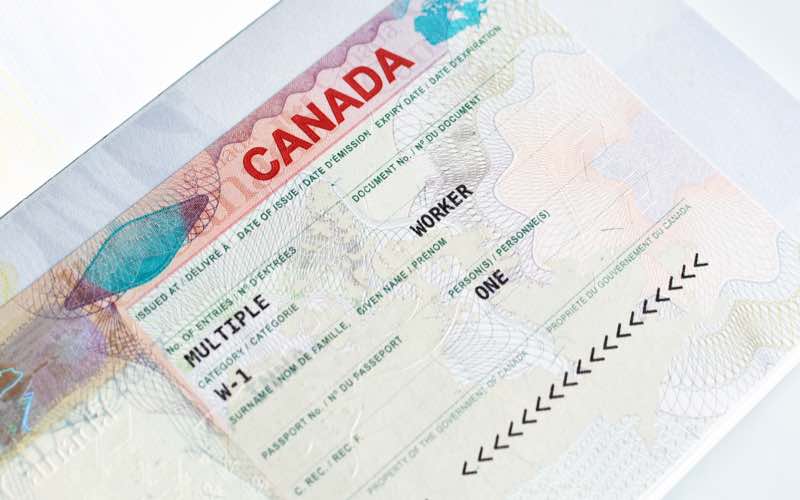Canada Work Permit Visa – The Complete Guide To Apply
While the Canada PR (Permanent Residency) process heavily depends on securing a job offer, getting a Canada Work Permit Visa (Written authorization to work in Canada) is a goal for many individuals to facilitate their immigration process and entry to Canada. For Canadian PR, a Work Permit can be obtained quickly, often in months instead of years. Plus, as the PR processing time is lengthier than a work permit, a work permit in Canada can help speed up the PR application process.
What is a work permit Canada?
A work permit will be issued by an IRCC (Immigration, Refugees and Citizenship Canada) officer that enables a Temporary Foreign Worker (TFW) who is not a Canadian citizen or a permanent resident to live and work in Canada for a specified time.
How do we get a work permit?
You can get a work permit under two major work permit programs:
The main difference is that the IMP allows Canadian employers to hire TFWs on a Canada Work Permit Visa without requiring an LMIA (Labour Market Impact Assessment). On the other hand, the regular TFWPs require employers to test the Canadian labour market to prove a labour shortage by receiving an LMIA and consequently applying for Work Visa Canada.
The TFWP is pointed at addressing labour shortages in Canada. Employers must conduct the LMIA process to prove to ESDC (Employment and Social Development Canada – Service Canada) that hiring a foreign worker is due to the lack of appropriate workers. The issuance of positive or neutral LMIA by ESDC will confirm that hiring a foreign worker will have no negative impact on the Canadian labour market. Then the employer provides a copy of positive or neutral LMIA to the foreign worker so that they can submit it along with their Canadian working visa application to the IRCC. Once their Canadian working visa application is approved, the employee can come to Canada to start working.
By contrast, the IMP helps Canada’s social, cultural, and economic objectives, so there is no requirement for a labour market test. Many IMP work permits are a result of Canada’s free trade agreements. For instance, the Canada-United States-Mexico Agreement (CUSMA, formerly NAFTA) is a prominent free trade agreement allowing U.S. and Mexican citizens to work in Canada without an LMIA. The spouses and the common-law partners of international students, PGWP holders, and skilled workers in Canada are eligible to get open work permit Canada under the IMP, allowing them to accept any job offer in Canada regardless of employer, occupation, or location.
On average, Canadian employers hire around 100,000 foreign workers yearly under TFWP and 300,000 under IMP.

1- Temporary Foreign Worker Program (TFWP)
Employers must obtain an LMIA to hire foreign workers to fill temporary labour shortages. An LMIA-based Work Permit (also known as a restricted-based or closed work permit) is needed by most employers before hiring a TFW to enable foreign workers to obtain a Canada Work Permit Visa to work in Canada. A positive LMIA will demonstrate a need for a foreign worker to fulfill the job. No Canadian worker or permanent resident is available to do the job, despite advertising the position at a competitive salary, thus requiring hiring a foreign worker.
When issued, it is essential to know that this work permit will be an employer-specific work permit, which means that the applicant may only work for the employer, the occupation. The spouses of the principal applicants may also be eligible to submit an Open Work Permit, and their children for a study permit for attending school in Canada. The location is stated on their work permit.
How can I get an LMIA work permit?
An LMIA-based work permit is a two-step application process:
- The first step is to apply for an LMIA to ESDC. Until further notice by ESDC, an LMIA decision letter is valid to support a TFW work permit application to the IRCC for 18 months after it is issued. The applicants must apply for their work permit within this timeframe. It is important to note that beginning on April 4, 2022.
- The second step is to submit a work permit application to the IRCC once an employer has obtained a positive LMIA from Service Canada.
How can I get the LMIA?
The LMIA process is employer-driven, meaning that the prospective employer initially submits this application, which is entirely professional and slightly separated from business actuality. The employers must demonstrate that they have completed the recruitment efforts and cannot hire a Canadian (PR or Citizen) candidate. ESDC publishes TFW guidelines that set out recruitment requirements and eligibility. While these requirements are not overly complicated, they are pretty specific. Even if the companies are optimistic that they cannot find a domestic candidate for the position, the application will likely have to go through LMIA-specific recruitment efforts. It is necessary to note that in addition to considering the impact on the labour market, ESDC officers assess the genuineness of the job offer by examining whether:
- The employer is actively engaged in the business – is the company providing goods or services?
- There is a reasonable employment need – is there a rational link between the business and the job offer?
- Can the employer perform the contract (The company’s financial situation)?
- Past compliance with Federal, Provincial and Territorial laws that regulate employment and recruitment?
What happens after LMIA is approved?
If the decision is positive or neutral, an LMIA will be issued, allowing the prospective employee to apply for a Canada Work Permit Visa.
How much does it cost to apply for LMIA?
For each Labour Market Impact Assessment application, a processing fee of CDN $1,000 is required (unless the application is made strictly in support of permanent residency). There is also a $100 CDN privilege fee needed.
2- International Mobility Program (IMP)
The IMP allows employers to hire temporary workers without an LMIA, which does not mean being exempt from obtaining a work permit required to work legally in Canada.
The IMP facilitates the entry of TFWs based on international trade agreements, Canadian interests, no other means of support, and humanitarian reasons. The TFWs should demonstrate that they will provide significant economic, cultural, or other competitive advantages for Canada and reciprocal benefits for Canadian citizens and permanent residents.
Can LMIA-Exempt WP lead to Canada PR?
The Foreign National coming to Canada under IMP will initially have a Work Permit issued for 1 or 2 years. So, it might renew for an extended period of up to 5-7 years. Following working in Canada for one year, the Foreign National might become eligible to apply for PR inside Canada by using CEC, FSW, or PNP programs based on individual circumstances. Some workers who are eligible for IMP include:
- Foreign Entrepreneurs/Self-Employed or Potential Provincial Nominees as entrepreneurs (C11 Work Permit)
- The Intra-Company Transfer (ICT Work Permit) Program is for those planning to transfer to a Canadian branch of the company they currently work for. (C12 Work Permit)
- International Free Trade Agreements: Those entering Canada as part of trade treaties, such as the Canada-United States-Mexico Agreement (CUSMA) or the Comprehensive Economic Trade Agreement (CETA).
- Post-Graduation Work Permit (PGWP) for those who have studied at and graduated from a Canadian Designated Learning Institution (DLI) and can obtain a PGWP for up to three years.
Can I apply for a Canada work permit visa without a job offer?
In most circumstances, to hire a temporary worker through the IMP, employers must pay the employer compliance fee and create and submit an offer of employment form through the Employer Portal. The offer of employment must include details about the business, the foreign worker, the job, wage, and benefits.
Once employers submit an offer of employment through the Employer Portal, they’ll get an offer of employment number. Then, they must give this number to the temporary workers they intend to hire. The temporary worker will get a letter of introduction from IRCC and a work permit from a Canada border services officer. Once the workers have this number, they can complete the Canadian working visa application to be reviewed by IRCC. The application will be approved if they’re eligible to work in Canada.
Who is eligible for a Canada work permit visa?
A job offer from a Canadian employer and a positive LMIA or proof that is LMIA-Exempt. To get the work permit, the applicants must submit a completed application that shows they meet the work permit Canada requirements of the IRCC, including the following:
- Meet the required experience and education to fill the position.
- Satisfy the IRCC officer that they will leave Canada after the authorized stay.
- Evidence of enough money to support themselves and their family while in Canada.
- Respect the law and have no criminal record.
- Be in good health and have a medical exam, if needed.

Canada Work Permit FAQs
Employer-specific work permits allow you to work in Canada under certain restrictions, such as your potential employer’s name, the length of your workday, and where you can work (if applicable).
Typically, a work permit application must be submitted before entry. Foreign nationals may occasionally apply at the border. The IRCC allows visitors to temporarily apply online for a Canadian Work Permit from within Canada because of COVID-19.
In Canada, there are two categories of work permit programs:
- Temporary Foreign Worker Program: To receive a work permit, a foreign person must complete a Labour Market Impact Assessment (LMIA).
- International Mobility Program: To get a work visa, a foreign national is not necessary to submit an LMIA.
The USMCA (United States-Mexico-Canada Agreement) has made it simpler for Americans and Mexicans to get work permits in Canada. There are still conditions that must be met, though.
The initial validity of the work permit can be three years, and the maximum to which it can be extended under the different programs is four years.
As a temporary worker, there is no predetermined maximum period that you can work in Canada. The job offer from your employer determines how long you can work. If your company needs to obtain one to recruit you, the period specified in your Labour Market Impact Assessment.
Applicants should pay $100 for the open permit holder cha and $155 for the work permit.
- Make a request online from outside of Canada.
- Finish the application, which must be accompanied by a medical examination (if necessary).
- After submitting your application, provide the results of your biometrics within two weeks (if needed).
Yes, your employer may engage a temporary employee like you under the International Mobility Program (IMP) without first conducting a Labour Market Impact Assessment (LMIA).
You are welcome to remain in Canada while IRCC reviews your request for a new work permit. This status is referred to as maintained status.
- Identity documentation. A passport or other travel document in good standing that allows you to return to the nation or territory it was issued.
- Evidence of employment within Canada.
- Evidence of a connection.
- Other paperwork.
If all the following were true when your post-graduation work permit (PGWP) application was submitted, you might work full-time while awaiting a decision. Your study permit was current. Your academic program was concluded.
There is no limit on the number of times a permit can be extended per Canadian immigration law. You should continue to meet the eligibility conditions.
A visa gives you the freedom to travel to and enter Canada. You need a permit to work or study in the country. You must follow each application step precisely and exactly to be qualified to live, work, or study in Canada.
Before coming to Canada, you must apply for a work permit from Immigration, Refugees and Citizenship Canada (IRCC) or a Canadian visa office. Regarding these employment permits: Before applying, you must have a work offer from a Canadian business. The second option is the IMP Work permit. Your employer may hire you as a temporary worker under the International Mobility Program (IMP) without conducting a Labour Market Impact Assessment (LMIA).
To qualify for permanent residency under the Canadian Experience Class, you must have achieved at least one year of Canadian Experience equal to 30 hours per week for 12 months of the following within the three years before applying.
Yes. A work permit is not a travel document, though. It does not provide you permission to visit Canada. You need a valid TRV to do so.
A work permit is required, though, so yes. Once you receive your acceptance of receipt (AoR) letter from us, your spouse or common-law partner, who you are sponsoring under the “Spouse or Common-Law Partner in Canada Class,” may apply for an open work visa.
The applicant’s circumstances are frequently a factor in the grounds for Canadian Work Permit refusal. Nonetheless, the following grounds may result in denial letters: You failed to provide evidence that you could successfully do the job you’re applying for.
Most of the time, fees must be paid by both employees and employers before a Canadian Work Permit is granted.
Your family members must apply to visit, work, or study in Canada if you are applying for a work permit and they wish to join you there. Others are free to apply at the same time as you.
Before 2021, there was a pathway from TR to PR that most people with work permits utilized to seek permanent residence. Now, to get Canada PR Visa (Permanent residence), if you are on a work visa, you would normally need to apply for an immigration program like the Canadian Experience Class.
You can work as a temporary worker in Canada for an unlimited period. Your employer’s job offer will determine how long you can work if your company needs to obtain an LMIA to engage you, the duration specified.
Within the first 90 days following its expiration, you can request to have your work permit reinstated. If you do this, you can remain in Canada until you receive further instructions, but you must stop working until your Canadian Work Permit has been restored.
Yes. If you meet the eligibility of a Canada PR visa, you can apply at any time.
If the Visa Officer believes you would not be able to complete the job offered to you adequately.
How Can We Help You?
At Arnika Visa, we help you to find the most tailored strategy to achieve your immigration goals. From filing the immigration forms to guiding you through supporting documents, we take care of it all. We can assist you entirely or partially based on our different packages. We can advise you professionally regarding the required personalized supporting documents to increase the chance of your approval and, finally, submit your application to IRCC on your behalf as an authorized representative. If you want to discover how the RCIC can help you, the first step is to complete the Assessment Form (To detail your personal, educational, and employment information) available on the site.




Okay I have understand everything,I am so interested work in Canada
Thanks for your valuable comment.
I need
Please fill out the assessment form. Thanks
Hello, I signed a contract with a company about two years ago; in the middle of the summer of 2023, I received a request for a visa, but this week, they called me and said that the immigration lawyer who handled your case had been sued in Canada, and that’s why the whole cases he handled are frozen. Your passport is also stuck in the Canadian embassy because of this; you should write a request that you want to change your immigration lawyer so that we can give your case to another lawyer. Now, I have a few questions for you; please guide me.
1- According to these conditions, is there a possibility of my visa rejection?
2- Considering that my visa started from the date of the pass request letter and if I want to start this new process, it will probably take several months, is there a possibility that because I come to Canada late, I will not be able to renew my work visa there or not? Can I get a Canada PR after one year of working in Canada? I got a two-year visa, but I may not be able to enter Canada for this delay.
Please answer me as soon as possible because I have a meeting with the company on Wednesday, thank you.
Given the complexity of your legal immigration questions, we recommend scheduling an appointment with our Regulated Canadian Immigration Consultant (RCIC) for accurate and personalized advice. His expertise will provide you with the necessary guidance for your specific situation. You can choose your preferred time for the appointment on the link below:
https://arnikavisa.com/book-a-consult/
I have an established software company in Canada (in Jan 2021) that is currently employing five employees on its payroll here in BC. I have been operating a software company in Pakistan since 2010. I would like to bring a software programmer from my Pakistan office to Canada using an intra-company transfer or ICT Visa. Would you please help us? Thanks
Since you have an established software company in Canada and wish to transfer an employee from your Pakistan office, you can utilize the Canada Intra-Company Transfer (ICT) Visa program. Ensure eligibility criteria, such as the employee’s seniority and job role, are met. Prepare necessary documentation and consult with a Canadian immigration expert for guidance.
Hi, I am from Bangladesh I applied for a Canada work permit with my family last year and got refused. The reason for refusal they mentioned in the GCSM notes is that I reapplied this time with the proper documentation, but this time, they refused my spouse and kids’ application, and my application is in process. My agency suggests I go to Canada first and then apply for the family after 2-3 months, but I don’t want to go alone; I want to take my family with me. I showed sufficient funds for them but was still refused. That is why I was looking for an immigration expert handling visa rejection cases, and I found yours. Under these circumstances, please suggest a possible way to take my family to Canada. I am looking forward to hearing from you. Thanks
Consider reassessing documentation, seeking guidance from a qualified RCIC or immigration lawyer, and exploring alternative immigration pathways. Options include appealing, reapplying with stronger evidence, or considering temporary separation if necessary. Utilize local resources for support.
I am writing to you regarding my query about the refusal of my work permit for a Canada Visa. As I have applied under LMIA exemption, I have mentioned the employment number in the application and also attached the required document for the compliance fee from the employer. However, as mentioned in my refusal letter, the reason was: “The employer has failed to pay the employer compliance fee, as required under section 303.1 of the IRPA.” Please help me with further processing, as I need to figure out what to do next. I appreciate any help.
Sure, we can help. Please email us the submitted application. We will contact you to let you know the real reason for the visa rejection. Thanks